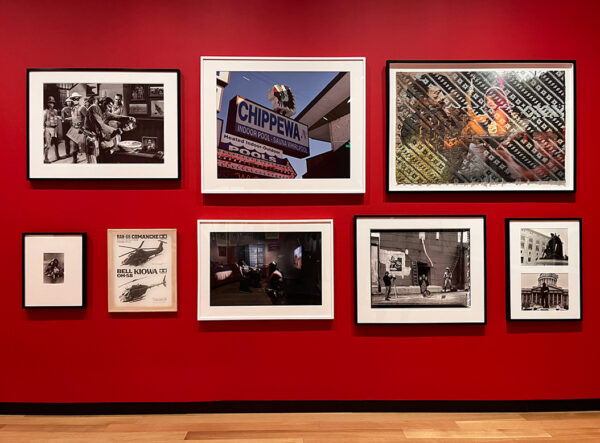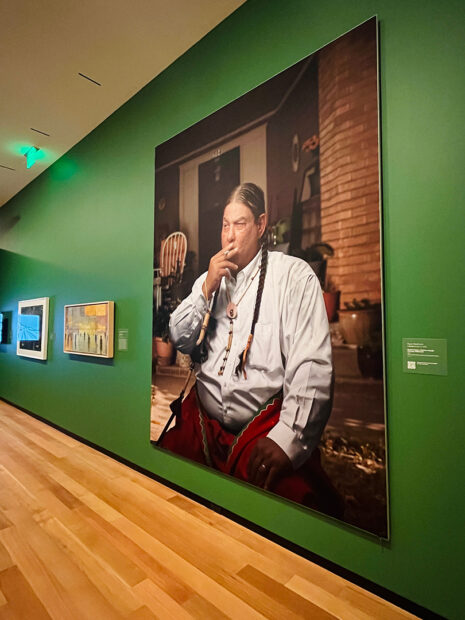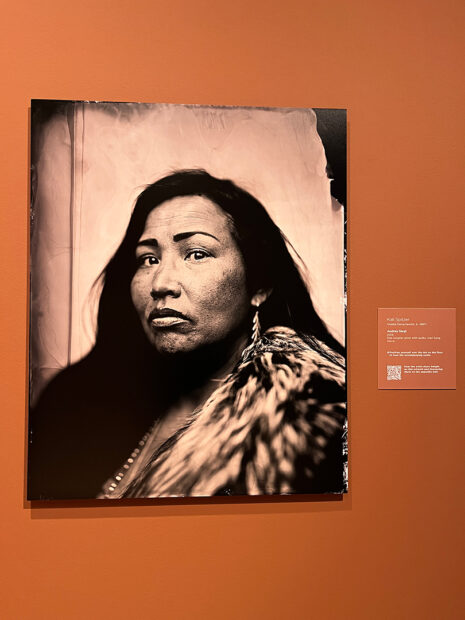Last month, the Amon Carter Museum of American Art debuted Speaking with Light: Contemporary Indigenous Photography. Touted as one of the first major museum exhibitions to present works by Indigenous photographers working today, the show includes approximately 70 pieces by more than 30 lens-based artists. The works, which span three decades, seek to reclaim representation while speaking to historical and personal trauma.
Coming on the heels of the Carter’s exhibition Black Every Day, co-curated by Kristen Gaylord and Dr. Lauren Cross, Speaking with Light is another collaboratively curated show. Recently, I spoke with John Rohrbach, Senior Curator of Photographs at the Carter, to learn more about the exhibition and about his experience working with co-curator Will Wilson, who is a Diné photographer.

Will Wilson and John Rohrbach speak at a press preview for “Speaking with Light: Contemporary Indigenous Photography” at the Amon Carter Museum of American Art.
Jessica Fuentes (JF): How long has this exhibition been in the works and at what point did you decide it would be necessary to have a co-curator?
John Rohrbach (JR): Around 8 years ago I started approaching Indigenous curators and scholars around the country for advice about shaping a future photography show about Indigenous people and cultures. They helped me immediately recognize the need to bring on an Indigenous curator or co-curator.
JF: How did you decide to invite Will Wilson to work on the project with you? When did he officially come on board?
JR: Will was recommended to me about two years ago by heather ahtone, Senior Curator at the First Nations Museum in Oklahoma City. Will and heather had worked together to create what became the 2017 exhibition and book Photo//Synthesis at the Fred Jones Jr. Museum of Art at the University of Oklahoma. The timing was right — Will had a sabbatical coming up from his teaching job as Photography Program Head at Santa Fe Community College in New Mexico. After a few extended email exchanges and phone conversations sharing thoughts about the state of the field and how we might shape this show, he graciously agreed to come on as co-curator.
JF: What excited you about working with Will?
JR: I liked the experience and perspective that Will could bring to the project. He is a teacher and an artist who had assembled other exhibitions of Indigenous art. I could bring my long experience working with museum photographic collections to the table, but I am an outsider to Indigenous worlds. I can learn the history and issues, but I do not live them. Will also brought a good eye and a willingness to engage in deep conversations about the direction and highlights of contemporary photographic practices among Indigenous artists.
JF: What was the co-curation process like? What aspects was Will involved with? What challenges arose? What were some of the most rewarding moments?
JR: It was collaborative and collegial from the start. Will was deeply involved in every aspect of the project, from suggesting artists and works, to shaping the project themes, to helping us engage scholars to write for the fine publication assembled by Radius Books. If there were any challenges, it was how quickly the project came together. Two years may seem like a long time, but assembling an exhibition and book in that time requires working at lightning speed.
There were so many rewarding moments. Will’s first visit to see the gallery space at the Carter made the project more real for both of us. Working out section themes, image sequences, and even wall colors was rewarding, as was writing the show’s texts. The ultimate reward for both of us, though, was hosting some of the exhibition artists at the show’s opening and hearing their enthusiasm for the presentation.
JF: What did you gain from this experience?
JR: It always is a pleasure to engage with top-notch artists who I had not known or engaged with before, but perhaps the most important aspect of this project for me was its constant challenge to step outside my Euro-American mindset.

Installation image from the “Survivance: An Ongoing Process” section within the exhibition “Speaking with Light: Contemporary Indigenous Photographers.”
JF: What is your favorite work or section of the exhibition and why?
JR: This is like asking which of your children is your favorite. The exhibition sections, Survivance, Nation, and Indigenous Visualities do not stand independently; they complement each other. One of the great things about photographs is that there are so many of them. I get to like different ones for different reasons.
In this show, I love the overwhelming size of Ryan RedCorn’s 10-foot-tall portrait of Everett Waller. Sarah Sense’s weavings have a beguiling tactility. Kali Spitzer’s blending of sound and image brings her friend’s heartache vividly alive. I could go on for a couple more pages.
JF: What do you hope visitors will take away from the exhibition?
JR: I hope that Indigenous visitors feel that they see their worlds reflected in the show’s texts and images. I hope non-Indigenous visitors come away with a deeper understanding of the challenges faced by Indigenous communities and an appreciation for those outlooks. I hope that everyone comes away excited and energized by the vibrant range of art that is being made today by Indigenous photographers.
JF: What exhibitions do you have in the works for the future, and will any of those be co-curated?
JR: Come January we will open my exhibition sharing Dallas photographer David H. Gibson’s extraordinary photographs of dawn in central Texas and New Mexico. Late next summer I get to present a show from the Carter’s deep photographic holdings. I don’t have another co-curated project in my immediate future, but that does not mean co-curation is out of the picture.
Speaking with Light: Contemporary Indigenous Photography is on view at the Amon Carter Museum of American Art in Fort Worth through January 22, 2023.
This interview has been lightly edited for length and clarity.





